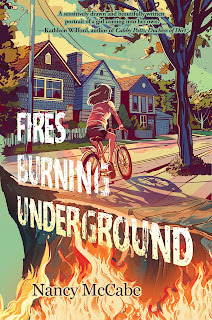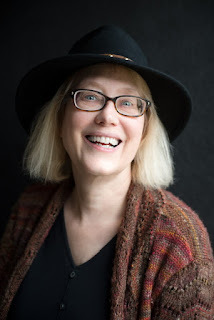Interview With Nancy McCabe, Author of Fires Burning Underground

Welcome to Smack Dab, Nancy. Please tell us a bit moreabout Fires Burning Underground.
It’ s Anny’ s first day of middle school and, after years ofbeing homeschooled, her first day of public school ever. In art, Larissa askswhat kind of ESP is her favorite: telepathy, clairvoyance, precognition, ortelekinesis? Tracy asks how she identifies: gay, straight, bi, ace, pan, trans,or confused? And thus kicks off a school year for Anny in which she’ llnavigate a path between childhood and adolescence, imagination and identity. Ina year of turmoil and transition, with a new awareness of loss after the deathof a friend, Anny struggles to find meaning in tragedy, to come to terms withher questions about her sexuality, and to figure out how to negotiate her ownever-shifting new friendships. And when her oldest friend’ s life is in danger,she must summon up her wits, imagination, and the ghosts that haunt her to savethem both.
The title’s a powerful one, as the metaphor of firesburning runs throughout the novel. Could you please talk about this imagery abit and how it relates to Anny’s journey?
Two literal fires bookend the story—the fire that killsAnny’s Sunday School classmate at the beginning, and the fire at the end thatforces Anny to think quickly and take action. In addition, images of fire arealways burning in Anny’s subconscious as she tries to make sense of herfriend’s death and the fears that result. But there are so many thingssmoldering below the surface for Anny—her passions for art and for friendshipthat don’t always have an outlet, her definition of who she is in relation to thereligious environment in which she was raised and as she stands on the brink ofadolescence, torn between the task of understanding herself and finding someway to name who she is that the rest of the world will understand.
I was fascinated by the intersection of faith andidentity–could you talk a bit about what made you want to weave these threadstogether, as Anny questions both her own sexuality and her religiousupbringing?
Faith and identity were quite honestly the sources of hugequestions for me at Anny’s age. The religious faith of my parents and churchoften seemed to be actively working to alter if not cancel my identity andshape me into a different kind of person. There wasn’t a lot of room for a quietgirl who had a strong sense of self and an innate inability to be dishonestabout who she was. I struggled to reconcile my own questions about faith andidentity, and wanted to examine those things through Anny. She uses morecontemporary language and ideas to express herself, but she shares mypre-adolescent combination of confidence and self-doubt.
Similar issues are so ubiquitous for the college students Iteach. They write about their conflicted ideas about religious upbringings.They often feel out of place because of a variety of factors: creative spirits,choices about sexual identity, mental health challenges. Religion and identityquestions are often closely intertwined.
As an offshoot to that, I was also intrigued by yourrepresentation of supernatural elements, such as the Ouija board. What made youinclude the supernatural alongside spiritual explorations?
When I was young, I was terrified of being haunted. Ateight, after my maternal grandpa died, I slept with my hand under my pillow toblock out the sound of his voice if his ghost tried to speak to me, and, likeAnny, I had a superstition about eating using his silverware. Much of Fires isbased on a year-long period when I was young, also bracketed by two fires, andan intense friendship that, looking back, was really the last one completelydominated by childhood concerns, imagination and creativity and games anddreams. We did play with the Ouija Board and were completely sucked in by ourbelief in the supernatural—another source of nightmares for me when I fearedthat the boy who’d died might speak to me. I changed much of what reallyhappened with my own Ouija board experience to serve the story better, but asfor me it becomes a symbol for the subtle beginnings of Anny’s rebellionsagainst her parents’ beliefs, her questions about them, and her process offinding her own power.
I’m a sucker for voice, and was impressed by the way youmanaged to deal with such really adult topics (death, sexuality, family issues)while maintaining a true-to-life MG voice. How did you strike the balance?
I had always written for adults when I started this book, sothis was a new challenge for me. An editor I worked with at a conferenceimpressed on me the importance of finding Anny’s voice. I read and reread a lotof middle grade fiction, listened to the way my daughter talked at that age,and went back to my sparse childhood diaries. I took many passes through themanuscript, looking at each sentence, trying to tune into Anny: how would shesay this? It was important to back off and let Anny’s voice take over.
The character of Robert dies early in the story butcontinues to maintain significance throughout. Was that difficult keepingsomeone in the text who isn’t present to interact with the characters?
Since the story is more about Anny’s reaction to her firstencounter with a peer’s death than about Robert himself, who she acknowledgesshe didn’t know very well, I’m not sure we ever find out much about Roberthimself. I deliberately left some questions open-ended, like is she reallyinteracting with him? How much of this is a function of her imagination? Isthere something supernatural going on? Just as young people have to make theirown decisions about questions of faith since there are no definitive answers, Iwanted young readers to be able to ponder the ambiguities of the supernaturalexperiences and decide for themselves.
I was intrigued by the presentation of art and music.What made you want to include creativity as a powerful force in the story?
Creativity and imagination, art and books are central toAnny just as they have always been central to me. Like Anny, I cared way moreabout those things than I did about gossip and crushes (and even when myhormones kicked in rather powerfully, I still felt most alive when reading agood book or creating something of my own.) Like Anny, I had many artisticimpulses and lacked the skill to execute most of them. I thought you had to begood at things to do them—like Anny, I made rugs and skirts and pillows, playedthe piano, got stuck in honors art where I felt totally out of my element,wrote stories and poems. But Anny doesn’t necessarily have to be good at thesethings to find power and refuge in them. I think that her ability to do thatand connect to others through art and writing are always going to be moreimportant to her than the labels she accepts for herself.
The novel explores different types of friendships. Whatdo Anny’s relationships with Larissa and Ella reveal about her journey?
Ella represents home and safety; Ella has also beenhomeschooled and is Anny’s oldest friend. Anny at once values the friendshipand finds it unsatisfying. But Ella isn’t staid or conventional any more thanAnny is. Ella is curious, she’s the catalyst for pushing them both out into theworld when she announces she’s going to public school, and she’s also sure ofwho she is. She’s always been a stabilizing force for Anny. But for Anny,Larissa represents the attractions and dangers of the outside world, someonewho is like Anny in some vital ways but also wants to try on differentidentities and dreams and lacks Anny’s fears. Anny comes to understand that sheneeds what both of her friends represent.
This is a scary time for so many sectors of society,especially LGBTQ+ youth. What might you say to them? What did you want toimpart with Anny's relatively optimistic ending?
Anny’s mother makes it clear that she will grudgingly accepther daughter no matter what choices she makes, but it’s in adon’t-ask-don’t-tell kind of way. Her interpretation of religious faith maycontinue to create obstacles for Anny. But what I wanted to emphasize is Anny’sstrong, creative spirit that is going to plow forward no matter what, becauseshe really doesn’t have any choice but to be who she is.
This is indeed an alarming time. When some sectors seek tolimit LGBTQ+ youth, I believe we need to produce and embrace a broad range ofaffirming art and literature. I fully believe that books can change our lives.I hope that young people will seek out allies and stories and role models thatencourage them to explore and express their identities and understand that noone has the right to try to change them.

What’s next?
I’m in the process of shifting from teaching to writingfull-time. I’d like to do another middle grade novel from Larissa’s point ofview. I’d like to explore what happens to Anny as well. I’ve been also workingon a sequel to my young adult time travel novel Vaulting through Time.I’m almost done with a collection of essays about a mysterious illness mydaughter experienced as a teenager. I’m like Anny—I have a zillion projects Iwant to work on and I’m excited about all of them.
Where can we find you?
My website is at https://www.nancymccabe.net.
Pre-order a copy of Fires Burning Underground



